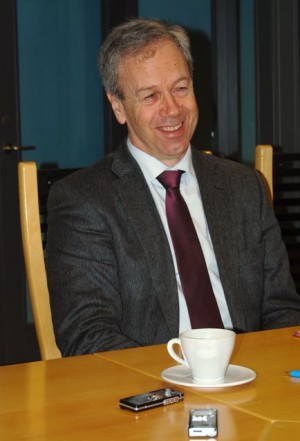Øystein Olsen, head of Norway’s central bank, was still smiling this week, even after his proposal to further limit use of oil revenues was torpedoed by a united government last week. And he told foreign correspondents in Oslo on Tuesday that he still thinks politicians shouldn’t spend more than what the fund holding the oil revenues is earning.

Olsen, unlike Finance Minister Sigbjørn Johnsen, did not take off on Norway’s annual winter holiday (Vinterferie) this week. He remained at work and met with members of the Foreign Press Association for a wide-ranging look at the economy, both in and out of Norway.
His bold comments in his annual address at the Bank of Norway last Thursday, though, caught the most attention after having placed him firmly in the Norwegian news picture over the past several days. He shows few signs of backing down from his proposal to reduce the rule that regulates use of oil revenues (called handlingsregelen in Norwegian) from 4 percent of the size of Norway’s so-called “oil fund” to just 3 percent.
“You can call it advice,” Olsen said on Tuesday. “I have a longer term perspective on this. I think it’s part of my role (to advise), and I can’t promise I’ll never mention it again.”
He quickly added that he won’t take part in public debate on the issue, though, and stressed that it’s “up to the politicians” to decide how much of Norway’s oil wealth should be saved and how much can be spent.
Olsen, who took over as central bank boss last year, is clearly worried, though, that the average returns on the fund over the past several years are below the 4 percent agreed on for the rule. As Prime Minister Jens Stoltenberg noted when trouncing on Olsen’s proposal right after it was presented, Olsen himself had been part of creating the rule back in the 1990s, and had even promoted 4.75 percent. Now Stoltenberg’s government, through Johnsen’s leadership of the Finance Ministry, actually is only spending around the 3 percent proposed by Olsen but opposes actually changing the rule itself.
Given the lower spending rate already in place, “why not be on the more moderate side?” queried Olsen. Yes, he acknowledged, the government is using less than the 4 percent allowed. “Stay there,” advises Olsen, and make it formal.
Stoltenberg, Johnsen and the leaders of the two other parties forming Norway’s government coalition won’t go along. Stoltenberg pointed out that if politicians change the rule now to 3 percent, what would stop them from later changing it again, to 5, 6 or 7 percent? That would damage the disciplinary effect the rule has. Politicians already can spend more than 4 percent (as they were willing to do when the finance crisis hit) or less (as they’re doing now). But the rule itself, they believe, should remain intact.
Olsen, charged with managing the fund, has continued to receive support in other quarters, not least from several local economists who also warn repeatedly against spending oil revenues instead of just the return on them. That’s what’s effectively happening, they argue, when the fund is only earning around 2.5 percent and more than that is withdrawn. “Spend the return, not more!” urged Olsen on Tuesday, while noting that the fund’s risk profile as a source of future pensions limits its returns because of the way funds are invested. He doesn’t think the oil fund will earn as much as 4 percent any time soon.
Dealing with the strength of the krone
On other issues, Olsen could confirm that Norway’s economy remains strong “in a world of unrest,” that optimism abounds, and that “most of our challenges are beyond our borders.” One, though, Norway’s record strong currency (the krone), continues to threaten exports and influence pending wage agreements.
Olsen carefully stayed away from predictions about interest rates, one of what he called the “important variables” that affect the strength of the currency and over which Olsen’s central bank has some control. Asked what kind of leeway the executive board of Norges Bank really has, since the bank’s key interest rate of 1.75 percent is already low, Olsen replied “but it’s not zero.” The bank board can reduce rates once again, like it did in December, when it meets next month.
Another cut, though, could further boost already high housing prices and add to fears of a so-called “housing bubble” that may finally burst. “It’s a dilemma,” Olsen conceded. “Wait until our report next month.”
Overall, Olsen said he thinks the economic picture outside Norway “is slightly brigher, I think, than it was before Christmas. If credit lines dry up, he vowed that Norges Bank “will be there, on behalf of Norwegian banks … we will stick to our role of providing liquidity.”
Views and News from Norway/Nina Berglund
Please support our stories by clicking on the “Donate” button now:

